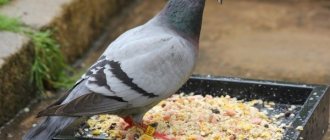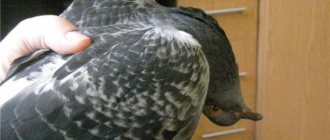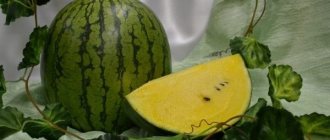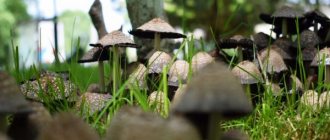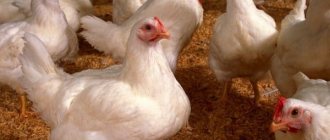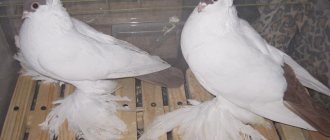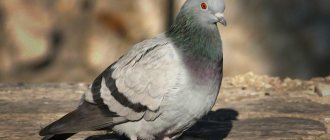The pigeon is probably the most common bird in the world. It is found in Europe, the Americas and Africa. Scientists know more than 300 species of these birds, and there are monuments to them in 30 cities around the world. Pigeons have become so integrated into human everyday life that sometimes it is difficult to imagine the streets of modern megacities without their restless bustle. However, with their offspring the situation is completely different; not everyone knows what a dove chick looks like.
Habits of pigeons
The most common breed of pigeon on city streets is the Caesar pigeon or Columba livia. These birds have long conquered megacities and are accustomed to people. They feed on everything they can find on the ground, from crumbs and plant seeds, to even bones and everything that can be pecked. Also in their daily diet they definitely need water and soil, sand or pebbles , which contribute to the normal functioning of the intestines and the timely digestion of food.
The ancestors of these birds lived on rocks and built their nests there, where they reliably hid their offspring from predators. This tradition is also characteristic of modern city pigeons, which live in flocks on the roofs of houses, abandoned balconies and attics rarely visited by people.
Description of the breed
Pigeons are so familiar to us that in everyday life on the city streets we sometimes don’t even notice them.
But we assure you that you will no longer be able to ignore this breed. Headed tickles are one of the most beautiful species of pigeons and are the favorite breed of many professional breeders. It's all about their unusual decoration - gray cheeks and beautiful elegant coloring of the head. See photo. Kavminvodsky bigheads were obtained from tickled pigeons and today they represent a separate branch. The bird developed its breed qualities over the course of 20 years, after which it received a separate status and its main characteristics. It is known that the homeland of these pigeons is Iran and Afghanistan. In general, these birds occupy a special position in culture and belief among many peoples of the world.
Kavminvodsky head tickled pigeons are valued today not only for their beautiful appearance, but also because they have retained their fighting abilities and flight qualities at the same time. This helps build the body. This breed has a small head with smooth plumage, a medium-sized body, a slender body, quite expressive eyes, a small white-black beak and a regular tail consisting of 12-14 feathers. The legs are mostly devoid of feathers, but there are also representatives “with panties,” which gives the birds a special zest.
A separate topic for conversation is the color of the feathers. Headed tickled pigeons are found both black and gray, but their main color is white with red or yellow spots or specks in the area of the head, forehead, cheeks and sometimes on the body. The color of the plumage on the tail is also different, which, as a rule, is arranged in a herringbone pattern.
Flight Features
The unique tickle-headed pigeons are popular not only for their coloring, but also for their special way of flying. This bird is very active, their flight is beautiful and long, and they love to somersault in the air up to 20 times in a row. This creates an unusual spectacle. In general, the flight is mostly circular with loud pops. Often these pigeons enter the pillar and then begin to beat their wings loudly.
The flight takes a long time, it can even take up to 8 hours. That is why big-headed ticklings are often called savages. They are difficult to tame; they can fly away at night or not arrive at all for several days. But if he has already returned after his adventures, then we can assume that the bird has already been domesticated. These are the unusual, cheeky, big-headed birds of the Caucasus Mountains of the world!
Pair selection
The Sisaris, like the rest of the family, are monogamous and, before starting a family and having offspring, choose a mate for life. By nature, the male of this bird is more beautiful than the female, and he has the role of winning the heart of the dove he likes. He draws the attention of his chosen one to himself with an intricate dance, where he demonstrates all his strength and beauty of plumage.
Even when a flock of pigeons flies somewhere to feed, the couples always stay together and try to stay close to each other. A group of birds has its own laws and rules and there is always a leader whom everyone obeys.
Reproduction
All members of the pigeon family are monogamous. Having found a mate, pigeons live together all their lives .
Before mating, the male performs a whole ritual:
- shows off in front of the female for a long time, attracting her attention;
- he does not leave his object of adoration for a second;
- coos loudly and persistently;
- swells the neck;
- spreads wings;
- His signature move is a vertical stand with his tail spread out like a fan.
If the female has accepted courtship, the birds “kiss”, cleaning each other with their beaks.
Both wild and city pigeons nest in secluded places inaccessible to predators. In natural conditions, they prefer caves or crevices. In the city they live in beams under bridges and in attics.
Interesting: The mating season of parrots and its features
Finding a nesting site
Reproduction and nesting of sisars occurs during the warm period of the year from April to September, maximum October.
The male looks for a place to build a nest and raise pigeons on his own, and only after he has finally won it from other contenders and made his choice does he invite the female there. The last word in choosing a nesting site always remains with the female, who will have to establish a family “life” there, hatch eggs and raise offspring. The expectant mother sits for some time in the place chosen by the male and tries on whether it will be convenient for her to breed her offspring there. At this moment, the partner is patiently waiting nearby for his companion to decide.
The criteria by which sisari choose a nesting site are:
- distance from prying eyes;
- security from external enemies;
- Convenient for laying and growing babies.
Having decided on a home for his cubs, the male brings branches and blades of grass to his partner, and she builds a nest, placing them under herself. After mating, the female usually lays 1-2 small eggs, similar in size to quail eggs. Both partners incubate them alternately, alternately flying to feed or simply resting from constantly sitting in one place.
Appearance
The body length is about 30 cm, the weight is rather large - about 400 g . The plumage is very thick, which allows them to survive frosts. In wild birds, the predominant color of the plumage is light gray with a greenish tint. A distinctive feature is two dark stripes on each wing. The plumage of urban birds is very diverse and has up to 30 shades. The bird can look completely different: there are both boiling white and purple-black. There is a small area of hairless skin around the eye. The beak is black, with a white wax at the base. The legs can also have different colors: from pink to black, in some birds they are partially covered with feathers. The wings are wide and pointed, with a span of up to 70 cm.
Interesting: How to find out the age of your budgie
Sexual dimorphism is not expressed. Females have only a slightly less noticeable metallic tint . Young birds of both sexes are identical up to 8 months, then males acquire a slightly noticeable gloss.
The appearance of chicks
After 20 days, the pigeon family is replenished and pigeon cubs are born. Little hairless lumps peck at the shell and hide under one of the parents, where it is warm and cozy. Adult birds get rid of egg remnants on their own, simply by pushing them out of the nest.
Small pigeons, chicks are rather inconspicuous, defenseless and clumsy. They have a large head, a naked body, occasionally covered with thin yellow down, and weak legs. Sisar cubs are born blind and helpless. Newborns initially weigh 10 grams and the firstborn is usually larger than his brother or sister.
The chicks develop quickly, and by the second day after birth they already weigh about 100 grams. It is noteworthy that the parents will feed the first cub 2-3 hours after birth, but for a baby stuck in the egg this time can last up to 20 hours, which can cause his death.
The places where pigeons live are jealously and vigilantly guarded by adult members of the pigeon family. When danger appears, one of the parents presses into the nest, completely covering the babies from a potential enemy, and the second parent flies to distract the uninvited guest and tries with all his might to take him to the side and as far as possible from the nest.
What a dove chick looks like (video)
What do pigeon chicks look like? Pigeon cubs are born in the same way as other birds - from eggs laid by females. Typically, a hatched little pigeon has the following qualities:
- no vision;
- no fluff;
- feathers are completely absent;
- weight reaches only 10 g.
Baby pigeons are born in the same way as other birds - from eggs laid by females
Even if children accidentally found and brought home chicks, only experts will be able to determine that these are small pigeons. This strange, rather unattractive, disheveled appearance can protect the lives of tiny newborn pigeons. A distinctive feature of the chicks is their large heads, so the babies cannot stand up for a long time. This process is hampered by the legs, which are not yet strong, and the low weight of the bird.
The beak develops very quickly, and in a week it can reach large sizes. According to the description, the cubs look like hairless, small chicks. They are not just small, but defenseless against predators and other dangers. The beak is constantly open, and the birds squeak all the time.
Few people know where pigeons are born and how they grow, because they will be seen only when the chicks reach large sizes and can move independently, get food, and fly. They are accepted into the flock already 2 months after birth, because then they are able to hunt, obey the laws of adults and look like adult birds.
The fluff on the body of pigeons appears after a certain time, which is associated with the rapid development of small birds. Full, uniform plumage grows after a month. Then the babies begin to leave the nest, afraid of the light and the world around them. But at the same time, the chicks try to flutter from place to place, preparing their wings for flight. In the second month after birth, pigeons undergo their first molt, when fluff and soft feathers begin to change to hard ones.
The beak develops very quickly, and in a week it can reach large sizes.
Babies are fed from the mother's crop, where food for them is formed and stored. This is a kind of liquid mixture that resembles milk in appearance. This is what the mother pigeon feeds her newborn chicks. Not all pigeons are the same size, and they grow unevenly. There will always be a weaker and smaller one, while others will be stronger and larger.
Birds prefer to hide their chicks to protect them from predators. Among other reasons, it is worth noting the following:
- Nests are built in caves or rocks. This tradition has a natural character, which pigeons adopted from their ancestors from the Mediterranean coast.
- In cities, pigeons make nests on the roofs of buildings and under window sills.
- They love to nest under bridges, high in trees, among dense branches.
- They build nests in hollows, in attics, in tall grass, on water and fire towers, and on the balconies of residential buildings that people rarely visit.
Birds try not to build nests in dovecotes, which is caused by human intervention. Therefore, when answering the question why we don’t see baby pigeons, it is worth taking this factor into account. Unwanted attention from the breeder can cause anxiety and aggression on the part of the birds. Only a small proportion of people have seen newborn pigeons, which is why descriptions of the appearance of newly born babies are contradictory and not always accurate.
Thinking about the appearance of the chicks, it is difficult to say anything other than that they are small, poorly feathered, absolutely weak, but with a huge open beak. Chicks appear in the most ordinary way, like any other birds - they hatch from eggs.
Newborn pigeons are unable to hear or see, since they lack hearing and vision for the first few days. There is also no down or feathers on their body at all. To understand that this is a pigeon chick in front of you, it will take a lot of effort, since it is quite difficult to distinguish it from other birds and only an experienced professional ornithologist can cope with this.
Photo of a newborn baby
Why they look this way is difficult to say. However, it is small size, blindness and deafness that save newborn pigeons’ lives. In the first few days, the chicks look rather inconspicuous and behave quietly, so they do not particularly attract the attention of predators.
As already mentioned, pigeons are born with a very large beak, but a small head and an even smaller body. It is because of this that pigeons cannot get up for some time. Although they do not weigh much - about ten grams. But even this weight cannot be supported by their small legs, which are still very weak. The same cannot be said about the beak of pigeons: it begins to grow in them already from birth, and after just a week and a half it becomes huge and strong.
We invite you to familiarize yourself with: Baku pigeons (19 photos): features of the fighting “Baku pigeons”, broad-tailed and many-feathered, high-flying and marbled species, necked and mirror birds
Also, baby pigeons have very large, bulging eyes. However, they are still covered with some kind of film, which is why the chicks do not see anything in the first days. The only thing they have enough strength for is a subtle squeak. If the baby pigeons feel cool when they accidentally roll out from under their father or mother, they try to crawl under them on their own.
Growing pigeons in the nest
Table No. 1. Weight of a pigeon chick.
| Age of the chick, in days | Chick weight, in grams |
| 10 | |
| 6 | 100 |
| 12 | 200 |
| 18 | 300 |
| 24 | 350 |
| 30 | 370 |
Several chicks hatched at the same time usually behave quietly, especially if they do not feel hungry. They press against each other, which allows them to retain heat.
Week old chicks
On the fifth or sixth day, the pigeons’ eyes open and they begin to distinguish sounds. At this age, small tubes appear on the body, which will later develop into thick feathers. After a week, the chicks try to stand on their own legs, but it is still too early for them to fly. Only on the twentieth day dove chicks become covered with feathers and begin to prepare for their first flight. By the end of a month of their life, they can already fly well.
Healthy diet
Pigeon offspring quickly gain weight and form the usual shape for this species.
Usually the chicks stay in the nest for up to 2 months, after which they begin to fly and join the adult flock. 3 weeks after hatching, the babies already weigh more than 300 grams and experience their first molt, during which the yellow down is completely replaced by full feathers. Such rapid maturation occurs due to the special nutrition that babies receive during their growing up and formation. In the mother dove's crop there are special glands through which the so-called “bird's milk” is secreted, a very high-calorie and nutritious mixture that provides the baby with everything necessary.
The older the sisar becomes, the harder the enzyme that his parents feed him becomes. After 18 days of “bird milk,” the food transforms into a thick porridge, and then the growing bird’s body learns to eat almost solid food.
Until the growing pigeons learn to fly and walk confidently, they practically do not leave the nest. The older the chick becomes, the more actively it begins to flap its wings and stretch; such exercise is necessary for training the muscles of the whole body and especially the wings.
The period of growing up of pigeon chicks
As mentioned earlier, a pigeon is born absolutely helpless; here there is a similarity with human children who cannot take care of themselves for a long time. Due to this lack of independence, at first there is always someone in the nest with the chicks - either a female or a male. You cannot abandon the brood even for a minute because the babies quickly lose heat, the thermoregulation mechanism does not work imperfectly, since the little pigeons are absolutely devoid of feathers, the parents warm themselves with the help of their bodies.
The parents leave the nest one by one, giving each other the opportunity to find food and drink water, but the pigeons know where their chicks are and hurry home. It was this affection and the presence of responsibility to each other that became the reason for the emergence of the stable expression “dove fidelity.” After all, pigeons are one of the few birds, and perhaps the only ones, that create pairs once and for all, raise children together and constantly support each other in summer and winter, this is called constancy.
However, along with this fact, there are also very unpleasant and even repulsive facts concerning the life activity of pigeons. Among such examples is the situation when the chicks became orphans, that is, their parents, unfortunately, died. You shouldn’t expect help from other pigeons; they simply won’t pay attention to the orphans, won’t bring food and water, and the little ones will face inevitable death. A person may notice a problem if a pigeon chick has fallen out of the nest, that is, when there is no way to help, when it is found, but if earlier, then you can try to take over feeding the little pigeon chicks.
Dangerous moments
However, it often happens that 2 weeks after the birth of the first babies, the female lays eggs again. In this case, the older brood is looked after by the father, who raises them until the period when they leave the nest.
Pigeons do not stand on ceremony with sick chicks, simply pushing them out of the nest. Also, inevitable death awaits the so-called “fledglings”, that is, those who were able to fly away from the nest, but cannot return back. The parents simply physically cannot return him back to the nest, and the rest of the birds in the flock of other people’s children simply ignore him.
It also happens that such early, not yet mature birds are picked up by people. In this case, it is worth remembering that from that moment on, the person who picked up the chick is fully responsible for it and its future life. Very often, fledgling babies rescued in this way remain to live with the person, rarely flying away as they grow up. If in nature sisars live up to 5 years, then their life in captivity can last up to 15 years.
Feathered young
Pigeons develop at a very fast pace by feathered standards. Already two months after birth, the young fledge and join the flock. It seems that the recent chicks are already getting food on their own and have the appearance of an adult pigeon.
- Young animals are difficult to distinguish in a flock. Only an experienced poultry farmer will pay attention to minor differences. Juveniles lack shine in their plumage and do not have the characteristic iridescent “collar”. Such signs are characteristic only of mature birds.
- Young pigeons can also be distinguished by their behavior. They do not yet have sufficient flying skills and experience. In addition, the limbs of the young individuals are not fully strengthened. Therefore, young birds can be easily identified even on the street by their clumsy movement. Such pigeons usually drag either a wing or a leg and rise into the air for no reason.
The established habit of pigeons to be near people leaves them little chance of keeping their location secret. For true nature lovers, it will not be difficult to find a pigeon nest, and at the same time find out where the pigeon chicks are. That's not the point anymore. The main thing is to behave carefully, without scaring the birds and without touching the masonry . Then the pigeons will be born more than once again in this acquired and safe place for them.
Life of a pigeon in captivity
Having picked up a teenage pigeon, you should first of all bring it home and warm it up. It is also necessary to examine him for possible injuries or illnesses. The baby is sick if the following symptoms are present:
- discharge from the beak or nostrils;
- there is visible redness of the beak mucosa;
- the pupils have different shapes;
- the bird stands poorly or cannot stand on its own legs at all.
Often, when you are ill, you may experience poor appetite, but this is not always a sure sign. If a pigeon was just brought into the house or a few hours ago, then such a reluctance to eat and drink is just a stressful reaction to the situation.
If the chick is still sick, then you should contact an ornithologist. For those who decide to take care of their feathered pet’s health on their own, it’s worth stocking up on medications such as:
- "Enrofloxacin";
- "Biovit-80";
- "Lozevalem."
The first drug helps with a runny nose and discharge of fluid from the beak. "Biovit-80" is a feed antibiotic and is used to treat birds against parasites and viruses. "Lozeval" kills fungi and inflammatory infections.
In order to feed a baby pigeon yourself, it is worth remembering that it should be fed 3 times a day, and dinner should be the most high-calorie and voluminous. The minimum feed that a bird should receive per meal is 40-50 grams. The diet should include foods such as:
- millet;
- corn;
- peas;
- barley.
For faster growth of the chick and strengthening its immunity, it is worth adding glucose and other vitamins to the water. The volume of millet in the daily diet should be 30−40%, corn 10%, peas 15%, barley 20%.
It is necessary to take care of the cleanliness of the cage or box where the chick lives, and also regularly wash the drinking bowl. It is worth remembering that in the hot season, adult birds love to swim, so you need to give your grown pet this opportunity by collecting water at room temperature in a bowl, basin or other container. The feathered friend himself will tell you that it’s time for “bath procedures” when he starts to climb into the water of the drinking bowl or under the tap with the water turned on.
When keeping a pigeon at home, it is also worth remembering that you need to communicate with it, play and pay attention. This bird quickly gets used to a person and becomes his faithful friend for a long time.
We feed the pigeon chick ourselves
Wild pigeons are ideal parents who take the most careful care of their chicks. This cannot be said about domesticated pigeons living in dovecotes next to humans. Such birds may lose the power of their instinct, as a result of which this will greatly affect the babies.
Feeding chicks is not difficult
Step 1. Boil one egg, remove the yolk and grate it very finely using a flour strainer. Dilute the resulting yellow mixture with pre-boiled and cooled water. Add enough water so that the slurry resembles liquid sour cream.
Finely grated egg yolk
Step 2: Prepare your feeding tool. You can use a regular syringe. To do this, remove the needle and draw the resulting mixture into it. Syringe feed the pigeons. You can also put a pacifier on the syringe, or use a baby bottle.
Syringe feeding
Step 3. The pigeons should receive about 12-25 drops of gruel per meal. It is important here not to overfeed the baby: carefully monitor his behavior and if you see that he begins to turn away, you can remove the syringe until the next feeding. Repeat the feeding process hourly.
Grown-up pigeons can drink from a bottle
From the second week, start adding a little boiled egg white to your diet, which should also be ground. You can add grain to the diet, after steaming it, and add a drop of honey. Now feeding the chicks can be halved and they can be given food every two to two and a half hours.
At the end of the second week, you can give the pigeon whole grains, soaked in water for 10-12 minutes. The chick should consume about two to three grains per meal. Also continue to give the egg mixture, add grated carrots or finely chopped greens to it. Introduce each new product carefully, in small portions.
The process of teaching a pigeon to drink
It is necessary to teach pigeons to drink water. To do this, you can grab the chick by the beak, plunge the beak into the water, and then release the chick. You need to make sure that water does not get into his nostrils, otherwise the baby may choke. At this age, you can remove additional lighting if the baby pigeon is feeling well and is developing and growing correctly.
In the summer, chicks can live outdoors; in winter, they need to be taken indoors
Nest for pigeons Ø23 cm
Helping a chick survive and feed it is quite simple. This process only lasts one month. By the end of this age, the pigeon should grow to normal size, learn to eat large and small grains on its own, and fly. The only thing that will be required of you is to pour water and sprinkle grains. At one meal, a pigeon eats about one tablespoon.
The daily diet should include:
- compressed feed – 50% of the total amount of feed per day;
- millet – 30% of the total;
- peas, corn – 10%;
- grain crops – 20%.
If desired, food for pigeons can be purchased at a pet store.
Bird food
If you properly organize the babies’ nutrition and follow the correct proportions indicated by us in percentages, the pigeons will quickly gain weight and develop correctly. It is enough to feed the pigeon three times a day in the fourth week. Make the first two servings a little less, and give the third more. In general, a pigeon should eat at least 45 grams of food per day.
Monitor the condition of the chick. If you notice lethargy, difficulty breathing, lack of appetite, cloudy eyes or mucous discharge, your bird is probably sick. In order to restore health, you need to adjust your diet. During illness, include boiled rice and millet in your daily diet.
Pigeon chick, 30 days old
Pigeon chicks are always born small and defenseless. Until they reach a conscious age, their parents take care of them, protecting and helping the kids in literally everything. However, pigeons abandoned for some reason will not be able to live on their own and will soon die. Now you know how to feed chicks at home yourself, you know the main features of their development and character, and you will be able to take care of the chicks if you find yourself in a similar situation.
Leaving the nest
In the wild, teenage pigeons leave their nest and join a flock living nearby. Young animals can often be found in the feeding area of birds; they are distinguished by their dull color, fussy behavior and the absence of shiny feathers on their necks that shimmer in the sun. They have to go the same way as their parents, find a mate, build a nest and raise offspring.
Caesars rarely return to the same nesting site. This happens only when the location of the nest is particularly successful and convenient. If the couple nevertheless returned to the previous place, then she will always refresh the flooring of the future “children’s room”. Pigeon chicks do not return to where their parents live. Having left the nest, after some time they lose contact with them and live their own lives.
Despite the fact that the French call pigeons “garbage rats,” these birds are quite beautiful and distinctive. Sisari are very caring parents and loyal friends to humans if they are tamed.
Where do the chicks grow?
Pigeons have many natural enemies. These include bad weather, cold, predators, etc. Where pigeon chicks escape from them is a separate question. If in the grass and forest there are more opportunities for mimicry, then in the city, close to people, it is difficult to protect pigeons.
Despite extremely developed parental feelings, the couple leaves the nesting site, near which a person was seen, without regret. It is easier for birds to lay eggs in a new place than to endanger future young.
Not finding the places where pigeon chicks spend most of their time, people came up with many fables about their appearance, questioning the very existence of pigeons.
Having no innate protection from external factors, little pigeons live for up to two months in carefully covered nests under the care of their parents, where the pigeon chicks are in relative safety.
In the wild, birds make nests among the branches of dense trees, hollows or in tall grass. In large cities, these can be the attics of tall buildings, water and fire towers, and balconies rarely visited by the owners.
Oddly enough, in specially built dovecotes on built nests, birds are not particularly willing to incubate the eggs. This is due to the fact that the dovecote is a place that is often visited by people, which causes anxiety in birds.
In everyday life, pigeons are characterized by some impudence; they practically sit on their heads and crawl under people’s feet. But when raising their young, the birds show almost manic caution. Therefore, few can see small pigeon chicks up close. Not only is the nest itself difficult to detect, but one of the parents completely covers the offspring with themselves, while the other will ward off potential danger in any way.
One of the reasons why there is little documented evidence of what pigeon offspring look like is that they mature early. Young animals are difficult to distinguish in a flock. Only experienced poultry keepers pay attention to the lack of shine in the plumage and the characteristic rainbow “collar”, which are characteristic only of mature birds.
Young birds can also be distinguished by their behavior. Not having sufficient flight experience, and having not yet fully strengthened limbs, young individuals move awkwardly, dragging either a leg or a wing, often rising into the air for no reason.
The inaccessibility of pigeon nests, the precociousness and natural caution of pigeons means that the young of these birds are not easy to see. While the chicks of other domesticated birds are constantly visible, pigeons rarely “advertise” their nests. Choosing the most secluded places for nests, birds also carefully camouflage them with grass, branches, leaves, etc.
Keeping nests in dark corners rarely visited by people makes pigeons and their chicks defenseless, this is especially evident immediately after birth. Pigeons are forced to fear everything, even the sun's rays. Their delicate skin, devoid of any protection, reacts painfully to ultraviolet radiation.
The habit of living close to humans leaves birds with little chance of keeping secret the places where pigeon chicks spend most of their time until the time comes for them to leave the nest. The mystery of what the offspring of pigeons look like and where they hide all the time is gradually ceasing to be a mystery. And for true nature lovers, finding a dove’s nest is not difficult. The main thing is to behave carefully, not to frighten the birds, not to touch the clutch, and then the baby pigeons will be born in this very place, and the parents will use the safe place for many more seasons, gradually strengthening and expanding the nest.


